
|
It brightened up to 11 mag in the SWAN images (Jan. 27, Vladimir Bezugly). It will fade out rapidly after this. Now it is not observable. It will appear in July in the Southern Hemisphere, or in September in the Northern Hemisphere.
Date(TT) R.A. (2000) Decl. Delta r Elong. m1 Best Time(A, h)
May 17 3 57.82 6 46.8 2.210 1.250 13 12.6 18:31 ( 94, -6)
May 24 4 22.78 6 35.4 2.259 1.307 14 13.0 18:28 ( 94, -6)
|

|
Bright new comet discovered in the SWAN images. It brightened rapidly up to 7.8 mag on Apr. 8 (Osamu Miyazaki). The nucleus was disintegrated, however, its remnant is still visible. Fading rapidly. It will be fainter than 18 mag in August. In the Northern Hemisphere, it will never be observable after this. It locates somewhat low in the Southern Hemisphere. But it will become high in summer.
Date(TT) R.A. (2000) Decl. Delta r Elong. m1 Best Time(A, h)
May 17 5 4.40 -0 6.4 1.137 0.556 29 12.6 18:31 ( 97, 11)
May 24 5 17.79 -8 12.5 1.248 0.703 34 13.4 18:28 ( 89, 14)
|

|
It brightened up to -3 mag due to the forward scattering on Oct. 9 in the SOHO coronagraph images (Q.-c. Zhang, Charles S. Morris). It became a great comet of 0 mag on the ground. Now it is 12.6 mag (Apr. 26, Hiroshi Abe). Fading slowly. In the Northern Hemisphere, it stays observable in good condition. It locates somewhat low in the Southern Hemisphere. But it will become high in spring.
Date(TT) R.A. (2000) Decl. Delta r Elong. m1 Best Time(A, h)
May 17 20 0.35 26 23.2 3.467 3.793 101 13.0 4:22 (180, 29)
May 24 19 52.48 27 16.8 3.463 3.875 106 13.1 3:47 (180, 28)
|

|
It is visible at 12-13 mag in the SWAN images (May 2, Vladimir Bezugly). Fading gradually. In the Northern Hemisphere, it is not observable now, but it will appear in July. It stays extremely low in the Southern Hemisphere. But it will become high in autumn.
Date(TT) R.A. (2000) Decl. Delta r Elong. m1 Best Time(A, h)
May 17 1 52.56 4 21.3 2.013 1.231 29 13.3 5:21 (257, 11)
May 24 2 18.62 6 17.2 2.009 1.226 29 13.2 5:25 (254, 11)
|

|
It approached to Sun down to 0.09 a.u. on Jan. 13. It brightened up to -2 or -3 mag and it was detected even in the daylight. The nucleus was disintegrated on Jan. 19. However, its remnant is still visible. Fading gradually. In the Northern Hemisphere, it will never be observable after this. In the Southern Hemisphere, it stays observable in good condition.
Date(TT) R.A. (2000) Decl. Delta r Elong. m1 Best Time(A, h)
May 17 2 14.33 -50 40.7 2.767 2.639 72 13.4 5:21 (312, 33)
May 24 2 26.23 -52 15.3 2.805 2.741 75 13.6 5:25 (313, 36)
|
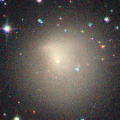
|
Now it is 12.7 mag (May 20, Osamu Miyazaki). It will be getting lower gradually after this, and it will be unobservable in July in the Northern Hemisphere, or in August in the Southern Hemisphere.
Date(TT) R.A. (2000) Decl. Delta r Elong. m1 Best Time(A, h)
May 17 9 39.08 10 32.4 6.239 6.277 87 14.0 18:31 (169, 44)
May 24 9 41.04 10 22.0 6.351 6.278 81 14.0 18:28 (161, 43)
|

|
Now it is 13.4 mag (May 20, Osamu Miyazaki). It stays 15 mag for a while. It stays observable in good condition.
Date(TT) R.A. (2000) Decl. Delta r Elong. m1 Best Time(A, h)
May 17 15 17.32 -5 42.1 4.351 5.338 165 14.0 23:36 (180, 61)
May 24 15 14.51 -4 51.7 4.393 5.357 160 14.0 23:05 (180, 60)
|

|
Now it is 14.9 mag (Feb. 4, Alfons Diepvens). It stays 14 mag for a while. It locates somewhat low. But it will become high in summer in the Northern Hemisphere, or in winter in the Southern Hemisphere.
Date(TT) R.A. (2000) Decl. Delta r Elong. m1 Best Time(A, h)
May 17 1 38.43 14 28.3 4.745 3.883 28 14.3 5:21 (246, 7)
May 24 1 47.23 15 22.8 4.688 3.873 32 14.2 5:25 (242, 11)
|
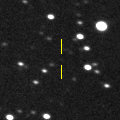
|
Now it is 15.2 mag (May 10, Taras Prystavski). Fading slowly. In the Northern Hemisphere, it is not observable now, but it will appear in June.
Date(TT) R.A. (2000) Decl. Delta r Elong. m1 Best Time(A, h)
May 17 1 9.93 -1 49.2 2.742 2.092 41 14.4 5:21 (255, 23)
May 24 1 24.11 -0 43.2 2.711 2.108 44 14.5 5:25 (251, 26)
|

|
Now it is 14.5 mag (Apr. 21, Hiroshi Abe). It will fade out rapidly after this. It will be fainter than 18 mag in September. It will be unobservable in July.
Date(TT) R.A. (2000) Decl. Delta r Elong. m1 Best Time(A, h)
May 17 6 14.17 23 6.4 2.160 1.487 37 14.6 18:31 (127, 9)
May 24 6 38.26 23 53.9 2.206 1.509 36 14.8 18:28 (128, 9)
|
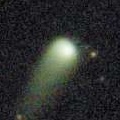
|
It was observed at 12-13 mag for a long time in 2024. Now it is 14.6 mag (Apr. 29, Ken-ichi Kadota). It stays 15 mag for a while. In the Northern Hemisphere, it will be getting higher gradually. In the Southern Hemisphere, it is not observable now.
Date(TT) R.A. (2000) Decl. Delta r Elong. m1 Best Time(A, h)
May 17 1 50.15 49 12.3 5.030 4.261 36 14.6 5:21 (220,-16)
May 24 1 51.71 49 41.0 5.033 4.292 38 14.7 5:25 (217,-13)
|

|
Now it is 14.6 mag (May 10, Alfons Diepvens). It stays 15 mag for a while. It will be unobservable in June. But it will be observable again in August.
Date(TT) R.A. (2000) Decl. Delta r Elong. m1 Best Time(A, h)
May 17 6 51.64 16 26.5 6.187 5.544 46 14.9 18:31 (129, 20)
May 24 6 57.27 16 46.9 6.255 5.536 41 14.9 18:28 (125, 17)
|
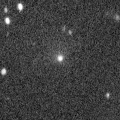
|
Very large comet. It is expected to brighten up to 13 mag in 2031. Now it is 14.9 mag (May 3, Thomas Lehmann). It stays 15 mag for a while. In the Northern Hemisphere, it is not observable now. In the Northern Hemisphere, it is not observable until 2030.
Date(TT) R.A. (2000) Decl. Delta r Elong. m1 Best Time(A, h)
May 17 4 19.58 -65 22.9 15.189 15.136 85 15.2 18:31 ( 30, 32)
May 24 4 24.92 -65 22.9 15.146 15.113 86 15.2 18:28 ( 29, 30)
|
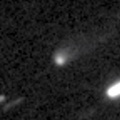
|
Now it is 15.7 mag (May 7, Thomas Lehmann). It stays 15 mag for a while. It locates somewhat low in the Northern Hemisphere. In the Southern Hemisphere, it stays observable in good condition.
Date(TT) R.A. (2000) Decl. Delta r Elong. m1 Best Time(A, h)
May 17 19 0.88 -28 23.2 2.152 2.930 132 15.3 3:23 (180, 83)
May 24 19 0.06 -28 53.4 2.086 2.928 139 15.3 2:55 (180, 84)
|

|
Brightened rapidly. Now it is 14.6 mag (Jan. 31, Thomas Lehmann). Fading slowly. It stays extremely low in the Northern Hemisphere. But it will become high in summer. In the Southern Hemisphere, it will be getting higher gradually.
Date(TT) R.A. (2000) Decl. Delta r Elong. m1 Best Time(A, h)
May 17 1 23.39 12 47.5 2.735 1.954 32 15.3 5:21 (245, 11)
May 24 1 35.53 11 27.9 2.710 1.988 36 15.4 5:25 (243, 16)
|

|
Now it is 16.5 mag (Apr. 7, Alfons Diepvens). It stays 15 mag for a while. Now it is not observable. It will appear in August.
Date(TT) R.A. (2000) Decl. Delta r Elong. m1 Best Time(A, h)
May 17 4 58.40 20 23.8 3.439 2.510 19 15.4 18:31 (113, -2)
May 24 5 12.58 20 30.2 3.455 2.499 16 15.4 18:28 (112, -4)
|

|
It brightened up to 12.7 mag in 2024 summer (Aug. 7, 2024, Thomas Lehmann). Now it is 15.5 mag (May 24, Martin Masek). It stays 16 mag for a while. In the Northern Hemisphere, it stays observable in good condition. In the Southern Hemisphere, it will be unobservable in August.
Date(TT) R.A. (2000) Decl. Delta r Elong. m1 Best Time(A, h)
May 17 23 15.19 31 16.8 3.477 3.083 59 15.4 5:21 (210, 16)
May 24 23 21.23 33 37.0 3.460 3.130 62 15.4 5:25 (204, 17)
|

|
Now it is 15.3 mag (May 13, Ken-ichi Kadota). Fading slowly. It will be getting lower gradually after this, and it will be unobservable in July in the Northern Hemisphere, or in August in the Southern Hemisphere.
Date(TT) R.A. (2000) Decl. Delta r Elong. m1 Best Time(A, h)
May 17 11 33.82 -11 48.2 2.852 3.491 121 15.4 19:52 (180, 67)
May 24 11 24.92 -9 56.4 2.988 3.504 112 15.6 19:16 (180, 65)
|

|
It is expected to brighten up to 13 mag in early summer in 2026. Now it is 16.0 mag (May 13, ATLAS-MLO, Mauna Loa). Brightening slowly. In the Northern Hemisphere, it stays observable in good condition. It locates somewhat low in the Southern Hemisphere. But it will become high in autumn.
Date(TT) R.A. (2000) Decl. Delta r Elong. m1 Best Time(A, h)
May 17 22 33.60 22 16.5 4.882 4.629 69 15.6 5:21 (205, 28)
May 24 22 31.38 22 51.9 4.733 4.591 75 15.5 5:25 (196, 30)
|

|
It is expected to brighten up to 5 mag in 2026 January. Now it is 16.0 mag (May 8, Ken-ichi Kadota). Brightening gradually. In the Northern Hemisphere, it stays observable in good condition. In the Southern Hemisphere, it is not observable now, but it will appear in July.
Date(TT) R.A. (2000) Decl. Delta r Elong. m1 Best Time(A, h)
May 17 18 7.09 56 32.2 3.598 3.866 97 15.7 2:29 (180, -2)
May 24 17 57.89 57 19.7 3.504 3.786 98 15.5 1:52 (180, -2)
|

|
It will brighten up to 13 mag in 2026. Now it is 15.9 mag (Apr. 29, Ken-ichi Kadota). It stays 15 mag for a while. It stays observable in good condition.
Date(TT) R.A. (2000) Decl. Delta r Elong. m1 Best Time(A, h)
May 17 19 44.17 -20 59.0 5.452 6.046 121 15.7 4:06 (180, 76)
May 24 19 41.57 -20 29.8 5.315 6.005 129 15.6 3:36 (180, 75)
|

|
It brightened up to 14.4 mag in winter (Feb. 4, Ken-ichi Kadota). Now it is 16.2 mag (May 13, ATLAS South Africa). Fading slowly. It will be getting lower gradually after this, and it will be unobservable in July in the Northern Hemisphere, or in September in the Southern Hemisphere.
Date(TT) R.A. (2000) Decl. Delta r Elong. m1 Best Time(A, h)
May 17 9 13.11 12 29.1 2.631 2.665 80 15.6 18:31 (161, 41)
May 24 9 21.41 11 41.0 2.724 2.673 76 15.7 18:28 (156, 40)
|

|
Now it is 15.3 mag (May 4, Toshiyuki Takahashi). Fading slowly. It locates somewhat low in the Northern Hemisphere. In the Southern Hemisphere, it stays observable in good condition.
Date(TT) R.A. (2000) Decl. Delta r Elong. m1 Best Time(A, h)
May 17 13 6.35 -28 36.2 2.816 3.690 144 15.6 21:25 (180, 84)
May 24 13 6.79 -27 29.8 2.880 3.708 139 15.7 20:58 (180, 83)
|

|
Now it is 16.2 mag (May 8, Ken-ichi Kadota). It stays 17 mag for a while. It will be unobservable in June in the Northern Hemisphere, or in September in the Southern Hemisphere. But it will be observable again in September in the Southern Hemisphere.
Date(TT) R.A. (2000) Decl. Delta r Elong. m1 Best Time(A, h)
May 17 10 48.00 -34 0.9 4.734 5.249 115 16.1 19:07 (180, 89)
May 24 10 43.70 -32 26.9 4.836 5.257 109 16.1 18:35 (180, 87)
|

|
First return of a new periodic comet which brightened up to 15 mag in 2010. Now it is 16.0 mag (May 11, ATLAS-HKO, Haleakala). It will fade out rapidly after this. It will be fainter than 18 mag in July. In the Northern Hemisphere, it will be getting lower gradually. It stays extremely low in the Southern Hemisphere.
Date(TT) R.A. (2000) Decl. Delta r Elong. m1 Best Time(A, h)
May 17 7 59.82 33 31.5 2.073 1.796 60 16.1 18:31 (152, 15)
May 24 8 21.69 32 21.2 2.149 1.831 58 16.3 18:28 (151, 16)
|

|
Now it is 15.6 mag (May 14, Alfons Diepvens). It stays 16 mag for a while. In the Northern Hemisphere, it stays observable in good condition. In the Southern Hemisphere, it will never be observable after this.
Date(TT) R.A. (2000) Decl. Delta r Elong. m1 Best Time(A, h)
May 17 10 36.83 65 43.7 4.412 4.328 78 16.1 18:57 (180,-11)
May 24 10 35.80 65 33.4 4.482 4.324 74 16.2 18:28 (180,-10)
|

|
Now it is 16.5 mag (May 8, Thomas Lehmann). It stays 17 mag for a while. It will be unobservable in June. But it will be observable again in August in the Northern Hemisphere.
Date(TT) R.A. (2000) Decl. Delta r Elong. m1 Best Time(A, h)
May 17 6 48.60 12 51.0 4.503 3.883 46 16.4 18:31 (125, 22)
May 24 6 53.26 14 0.8 4.585 3.880 41 16.4 18:28 (123, 18)
|

|
Now it is 16.2 mag (May 13, ATLAS South Africa). It stays 16 mag for a while. In the Northern Hemisphere, it is not observable now, but it will appear in September. In the Southern Hemisphere, it will be getting lower gradually after this, and it will be unobservable in July. But it will be observable again in July.
Date(TT) R.A. (2000) Decl. Delta r Elong. m1 Best Time(A, h)
May 17 7 6.27 -13 53.4 7.020 6.601 61 16.4 18:31 (105, 43)
May 24 7 10.81 -13 14.7 7.087 6.596 57 16.4 18:28 (102, 39)
|

|
Now it is 17.1 mag (May 7, ATLAS Chile). Brightening slowly. In the Northern Hemisphere, it will be getting higher gradually. In the Southern Hemisphere, it stays observable in good condition.
Date(TT) R.A. (2000) Decl. Delta r Elong. m1 Best Time(A, h)
May 17 22 48.70 -16 31.8 2.983 2.959 78 16.6 5:21 (240, 59)
May 24 22 55.86 -15 47.9 2.882 2.947 83 16.5 5:25 (230, 63)
|
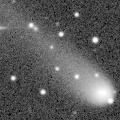
|
Now it is 16.4 mag (May 4, ATLAS South Africa). It stays 17 mag for a while. In the Northern Hemisphere, it is not observable now, but it will appear in September. It locates somewhat low in the Southern Hemisphere. But it will become high in summer.
Date(TT) R.A. (2000) Decl. Delta r Elong. m1 Best Time(A, h)
May 17 5 31.75 -37 4.5 7.806 7.397 62 16.8 18:31 ( 66, 35)
May 24 5 34.19 -36 44.1 7.874 7.442 61 16.8 18:28 ( 64, 30)
|

|
It will brighten up to 9 mag in 2026 spring. Now it is 17.3 mag (Apr. 30, Andrew Pearce). Brightening slowly. It will be getting lower gradually after this, and it will be unobservable in August in the Northern Hemisphere, or in September in the Southern Hemisphere.
Date(TT) R.A. (2000) Decl. Delta r Elong. m1 Best Time(A, h)
May 17 10 19.19 15 9.7 2.761 3.024 95 17.0 18:39 (180, 40)
May 24 10 21.74 14 43.2 2.822 2.984 89 16.9 18:28 (176, 40)
|
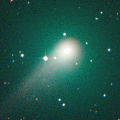
|
It was observed at 9-10 mag for a long time in 2023. Now it is 16.6 mag (May 15, ATLAS South Africa). It stays 17 mag for a while. In the Northern Hemisphere, it will never be observable after this. In the Southern Hemisphere, it stays observable in good condition.
Date(TT) R.A. (2000) Decl. Delta r Elong. m1 Best Time(A, h)
May 17 22 18.91 -66 39.2 7.109 7.408 103 17.0 5:21 (346, 56)
May 24 22 16.70 -67 37.0 7.089 7.460 107 17.0 5:25 (352, 57)
|
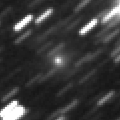
|
Very far object. Now it is 16.9 mag (Dec. 20, ATLAS Chile). It stays 17 mag for a while. In the Northern Hemisphere, it is not observable now. In the Southern Hemisphere, it stays observable in good condition.
Date(TT) R.A. (2000) Decl. Delta r Elong. m1 Best Time(A, h)
May 17 1 23.79 -53 12.1 10.888 10.720 77 17.0 5:21 (313, 41)
May 24 1 25.83 -53 13.8 10.836 10.730 81 17.0 5:25 (313, 46)
|

|
It brightened up to 13.8 mag in winter (Dec. 30, Thomas Lehmann). Now it is 17.2 mag (May 2, Toshihiko Ikemura, Hirohisa Sato). Fading slowly. It will be fainter than 18 mag in July. In the Northern Hemisphere, it will be getting lower gradually. It stays extremely low in the Southern Hemisphere.
Date(TT) R.A. (2000) Decl. Delta r Elong. m1 Best Time(A, h)
May 17 9 10.96 41 49.0 3.263 3.120 72 17.0 18:31 (169, 12)
May 24 9 20.16 39 53.3 3.380 3.161 68 17.1 18:28 (165, 13)
|
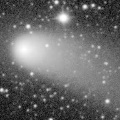
|
It brightened up to 9.6 mag from February to March in 2024 (Feb. 25, 2024, Thomas Lehmann). Now it is 17.0 mag (May 4, Ken-ichi Kadota). It stays 17 mag for a while. In the Northern Hemisphere, it stays observable in good condition. It stays extremely low in the Southern Hemisphere.
Date(TT) R.A. (2000) Decl. Delta r Elong. m1 Best Time(A, h)
May 17 23 32.44 38 53.1 6.023 5.511 55 17.1 5:21 (209, 8)
May 24 23 35.76 39 35.1 6.022 5.575 59 17.1 5:25 (204, 10)
|
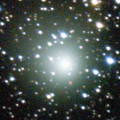
|
It brightened up to 8.3 mag in 2021-2022 winter (Jan. 6, 2022, Toshiyuki Takahashi). Now it is 17.7 mag (May 13, Jean-Claude Merlin). It stays 18 mag for a while. In the Northern Hemisphere, it will never be observable after this. In the Southern Hemisphere, it stays observable in good condition.
Date(TT) R.A. (2000) Decl. Delta r Elong. m1 Best Time(A, h)
May 17 11 52.08 -57 48.0 9.612 10.216 124 17.1 20:11 ( 0, 67)
May 24 11 51.06 -57 17.8 9.688 10.259 121 17.2 19:43 ( 0, 68)
|

|
Now it is 17.3 mag (May 6, ATLAS Chile). It stays 18 mag for a while. It will be unobservable in July in the Northern Hemisphere, or in September in the Southern Hemisphere.
Date(TT) R.A. (2000) Decl. Delta r Elong. m1 Best Time(A, h)
May 17 11 7.86 -29 51.6 4.786 5.352 119 17.2 19:27 (180, 85)
May 24 11 5.80 -28 5.6 4.873 5.350 112 17.2 18:57 (180, 83)
|

|
Now it is 17.4 mag (Sept. 20, Taras Prystavski). It stays 17 mag for a while. It stays observable in good condition.
Date(TT) R.A. (2000) Decl. Delta r Elong. m1 Best Time(A, h)
May 17 21 43.65 1 35.5 3.141 3.256 87 17.3 5:21 (198, 52)
May 24 21 47.58 2 15.0 3.063 3.271 92 17.2 5:25 (187, 52)
|
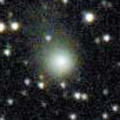
|
It brightened up to 12.1 mag in 2023 spring (May 20, 2023, Jose Guilherme de S. Aguiar). Now it is 17.4 mag (Mar. 25, ATLAS South Africa). It stays 18 mag for a while. In the Northern Hemisphere, it is not observable now, but it will appear in August. It locates somewhat low in the Southern Hemisphere. But it will become high in summer.
Date(TT) R.A. (2000) Decl. Delta r Elong. m1 Best Time(A, h)
May 17 5 52.78 -19 49.0 7.755 7.172 51 17.3 18:31 ( 87, 32)
May 24 5 56.18 -19 14.4 7.849 7.220 48 17.3 18:28 ( 85, 27)
|

|
Now it is 17.1 mag (May 1, A. Nagy Melykuti). It stays 17 mag for a while. It stays extremely low in the Northern Hemisphere. In the Southern Hemisphere, it will be getting lower gradually after this, and it will be unobservable in July. But it will be observable again in August.
Date(TT) R.A. (2000) Decl. Delta r Elong. m1 Best Time(A, h)
May 17 6 58.74 -5 16.4 4.944 4.456 55 17.3 18:31 (112, 37)
May 24 7 5.06 -5 17.7 5.009 4.453 51 17.3 18:28 (109, 33)
|

|
Now it is 18.0 mag (Feb. 2, ATLAS Chile). It stays 17 mag for a while. In the Northern Hemisphere, it is not observable now, but it will appear in July. In the Southern Hemisphere, it stays observable in good condition. It is expected to brighten up to 13 mag in winter between 2026 and 2027.
Date(TT) R.A. (2000) Decl. Delta r Elong. m1 Best Time(A, h)
May 17 2 22.81 -37 29.5 7.495 7.032 59 17.3 5:21 (298, 27)
May 24 2 28.54 -37 19.8 7.404 6.988 62 17.3 5:25 (296, 32)
|

|
It returned for the first time in 68 years. It brightened up to 6.2 mag in early last summer (July 1, Virgilio Gonano). Now it is 16.3 mag (May 10, ATLAS Chile). It will fade out rapidly after this. It will be fainter than 18 mag in June. It locates somewhat low in the Northern Hemisphere. In the Southern Hemisphere, it stays observable in good condition.
Date(TT) R.A. (2000) Decl. Delta r Elong. m1 Best Time(A, h)
May 17 18 33.29 -25 59.1 3.293 4.105 138 17.3 2:56 (180, 81)
May 24 18 27.84 -26 38.3 3.289 4.170 146 17.5 2:23 (180, 82)
|

|
Now it is 17.3 mag (Oct. 31, ATLAS Chile). It stays 17 mag for a while. In the Northern Hemisphere, it will be getting higher gradually. In the Southern Hemisphere, it stays observable in good condition.
Date(TT) R.A. (2000) Decl. Delta r Elong. m1 Best Time(A, h)
May 17 23 57.66 -4 5.6 3.722 3.303 58 17.4 5:21 (243, 38)
May 24 0 5.34 -3 26.9 3.642 3.307 62 17.4 5:25 (237, 42)
|

|
Now it is 17.3 mag (May 6, ATLAS Chile). It stays 18 mag for a while. In the Northern Hemisphere, it is not observable now, but it will appear in September. In the Southern Hemisphere, it will be getting lower gradually after this, and it will be unobservable in August. But it will be observable again in August.
Date(TT) R.A. (2000) Decl. Delta r Elong. m1 Best Time(A, h)
May 17 7 39.65 -27 18.7 3.827 3.704 75 17.4 18:31 ( 93, 57)
May 24 7 44.16 -25 4.8 3.907 3.697 70 17.4 18:28 ( 93, 52)
|

|
It returns for the first time in 70 years. It brightened up to 3.7 mag in early April in 2024 (Apr. 6, 2024, Jose Guilherme Aguiar). Now it is 17.9 mag (Mar. 14, ATLAS Chile). Fading slowly. It will be fainter than 18 mag in June. It stays extremely low in the Northern Hemisphere. In the Southern Hemisphere, it stays observable in good condition.
Date(TT) R.A. (2000) Decl. Delta r Elong. m1 Best Time(A, h)
May 17 16 21.07 -50 41.5 4.117 4.997 147 17.5 0:45 ( 0, 74)
May 24 16 12.04 -50 5.8 4.154 5.061 150 17.6 0:08 ( 0, 75)
|
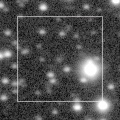
|
Now it is 16.9 mag (May 9, ATLAS South Africa). It stays 18 mag for a while. It stays observable in good condition.
Date(TT) R.A. (2000) Decl. Delta r Elong. m1 Best Time(A, h)
May 17 16 48.35 -22 14.9 5.731 6.703 162 17.6 1:11 (180, 77)
May 24 16 42.32 -21 30.2 5.688 6.690 170 17.5 0:38 (180, 77)
|

|
It brightened up to 13.1 mag in autumn (Nov. 1, Thomas Lehmann). Now it is 16.9 mag (May 14, Ken-ichi Kadota). Fading gradually. It will be fainter than 18 mag in June. It stays observable in good condition.
Date(TT) R.A. (2000) Decl. Delta r Elong. m1 Best Time(A, h)
May 17 17 18.78 10 5.1 2.346 3.196 141 17.6 1:41 (180, 45)
May 24 17 8.66 8 59.3 2.372 3.263 146 17.8 1:04 (180, 46)
|

|
Now it is 17.5 mag (Apr. 28, Yasukazu Ikari). It stays 18 mag for a while. In the Northern Hemisphere, it stays observable in good condition. In the Southern Hemisphere, it is not observable now, but it will appear in August.
Date(TT) R.A. (2000) Decl. Delta r Elong. m1 Best Time(A, h)
May 17 18 28.89 62 34.1 4.987 5.111 91 17.7 2:50 (180, -8)
May 24 18 11.78 63 14.1 4.965 5.107 92 17.6 2:06 (180, -8)
|

|
Now it is 17.9 mag (May 5, Alfons Diepvens). It stays 18 mag for a while. It stays observable in good condition.
Date(TT) R.A. (2000) Decl. Delta r Elong. m1 Best Time(A, h)
May 17 17 1.71 16 57.9 4.652 5.445 137 17.7 1:24 (180, 38)
May 24 16 59.45 17 12.4 4.611 5.422 139 17.7 0:54 (180, 38)
|
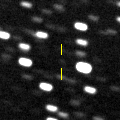
|
Now it is 17.3 mag (Mar. 6, ATLAS Chile). It stays 18 mag for a while. In the Northern Hemisphere, it will never be observable after this. In the Southern Hemisphere, it will be getting higher gradually.
Date(TT) R.A. (2000) Decl. Delta r Elong. m1 Best Time(A, h)
May 17 3 12.00 -47 52.2 5.548 5.242 67 17.8 5:21 (313, 23)
May 24 3 14.76 -48 9.4 5.524 5.259 69 17.8 5:25 (311, 28)
|

|
It brightened very rapidly up to 16.9 mag in spring (Mar. 30, ATLAS South Africa). Now it is 17.9 mag (May 14, Ken-ichi Kadota). Fading gradually. It will be fainter than 18 mag soon. In the Northern Hemisphere, it will be getting lower gradually. In the Southern Hemisphere, it stays observable in good condition.
Date(TT) R.A. (2000) Decl. Delta r Elong. m1 Best Time(A, h)
May 17 10 24.42 2 46.4 1.820 2.241 100 17.8 18:44 (180, 52)
May 24 10 33.21 2 34.0 1.901 2.248 96 18.0 18:28 (179, 53)
|

|
Now it is 17.8 mag (Apr. 17, Taras Prystavski). It stays 18 mag for a while. In the Northern Hemisphere, it will be getting lower gradually. In the Southern Hemisphere, it will never be observable after this.
Date(TT) R.A. (2000) Decl. Delta r Elong. m1 Best Time(A, h)
May 17 8 8.19 53 39.8 5.883 5.479 61 17.9 18:31 (162, -2)
May 24 8 14.95 52 30.2 5.967 5.488 57 17.9 18:28 (159, -3)
|
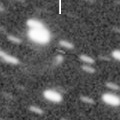
|
Now it is 17.6 mag (Apr. 26, Yasukazu Ikari). It stays 18 mag for a while. It stays observable in good condition.
Date(TT) R.A. (2000) Decl. Delta r Elong. m1 Best Time(A, h)
May 17 19 22.42 15 58.0 4.926 5.414 113 17.9 3:44 (180, 39)
May 24 19 16.33 15 57.3 4.872 5.449 119 17.9 3:11 (180, 39)
|

|
Now it is 16.7 mag (May 13, ATLAS South Africa). It stays 18 mag for a while. It stays observable in good condition.
Date(TT) R.A. (2000) Decl. Delta r Elong. m1 Best Time(A, h)
May 17 20 19.39 -20 23.3 4.156 4.654 113 17.9 4:41 (180, 75)
May 24 20 19.84 -19 58.2 4.080 4.671 120 17.9 4:14 (180, 75)
|
|
![]()
 C/2025 F2 ( SWAN )
C/2025 F2 ( SWAN ) C/2023 A3 ( Tsuchinshan-ATLAS )
C/2023 A3 ( Tsuchinshan-ATLAS ) 217P/LINEAR
217P/LINEAR C/2024 G3 ( ATLAS )
C/2024 G3 ( ATLAS ) 29P/Schwassmann-Wachmann 1
29P/Schwassmann-Wachmann 1 C/2021 G2 ( ATLAS )
C/2021 G2 ( ATLAS ) C/2022 N2 ( PanSTARRS )
C/2022 N2 ( PanSTARRS ) 48P/Johnson
48P/Johnson 49P/Arend-Rigaux
49P/Arend-Rigaux C/2022 E2 ( ATLAS )
C/2022 E2 ( ATLAS ) C/2022 QE78 ( ATLAS )
C/2022 QE78 ( ATLAS ) C/2014 UN271 ( Bernardinelli-Bernstein )
C/2014 UN271 ( Bernardinelli-Bernstein ) 65P/Gunn
65P/Gunn C/2024 J2 ( Wierzchos )
C/2024 J2 ( Wierzchos ) 43P/Wolf-Harrington
43P/Wolf-Harrington C/2023 C2 ( ATLAS )
C/2023 C2 ( ATLAS ) C/2024 L5 ( ATLAS )
C/2024 L5 ( ATLAS ) C/2023 R1 ( PanSTARRS )
C/2023 R1 ( PanSTARRS ) C/2024 E1 ( Wierzchos )
C/2024 E1 ( Wierzchos ) C/2024 J3 ( ATLAS )
C/2024 J3 ( ATLAS ) P/2023 S1 ( PanSTARRS )
P/2023 S1 ( PanSTARRS ) C/2023 T3 ( Fuls )
C/2023 T3 ( Fuls ) C/2023 F3 ( ATLAS )
C/2023 F3 ( ATLAS ) 496P/2024 S3 ( Hill )
496P/2024 S3 ( Hill ) C/2023 H5 ( Lemmon )
C/2023 H5 ( Lemmon ) C/2024 A1 ( ATLAS )
C/2024 A1 ( ATLAS ) C/2022 R6 ( PanSTARRS )
C/2022 R6 ( PanSTARRS ) 47P/Ashbrook-Jackson
47P/Ashbrook-Jackson C/2019 U5 ( PanSTARRS )
C/2019 U5 ( PanSTARRS ) 88P/Howell
88P/Howell C/2020 V2 ( ZTF )
C/2020 V2 ( ZTF ) C/2019 E3 ( ATLAS )
C/2019 E3 ( ATLAS ) C/2023 Q1 ( PanSTARRS )
C/2023 Q1 ( PanSTARRS ) C/2021 S3 ( PanSTARRS )
C/2021 S3 ( PanSTARRS ) C/2019 L3 ( ATLAS )
C/2019 L3 ( ATLAS ) C/2024 G2 ( ATLAS )
C/2024 G2 ( ATLAS ) 362P/(457175) 2008 GO98
362P/(457175) 2008 GO98 C/2020 K1 ( PanSTARRS )
C/2020 K1 ( PanSTARRS ) 195P/Hill
195P/Hill C/2024 T5 ( ATLAS )
C/2024 T5 ( ATLAS ) 13P/Olbers
13P/Olbers 302P/Lemmon-PanSTARRS
302P/Lemmon-PanSTARRS C/2024 X2 ( ATLAS )
C/2024 X2 ( ATLAS ) 12P/Pons-Brooks
12P/Pons-Brooks C/2024 G6 ( ATLAS )
C/2024 G6 ( ATLAS ) C/2024 B1 ( Lemmon )
C/2024 B1 ( Lemmon ) C/2023 V1 ( Lemmon )
C/2023 V1 ( Lemmon ) C/2024 G4 ( PanSTARRS )
C/2024 G4 ( PanSTARRS ) C/2023 U1 ( Fuls )
C/2023 U1 ( Fuls ) P/2010 LH155
P/2010 LH155 C/2024 N4 ( Sarneczky )
C/2024 N4 ( Sarneczky ) C/2022 U1 ( Leonard )
C/2022 U1 ( Leonard ) C/2023 H1 ( PanSTARRS )
C/2023 H1 ( PanSTARRS )![]()

















































